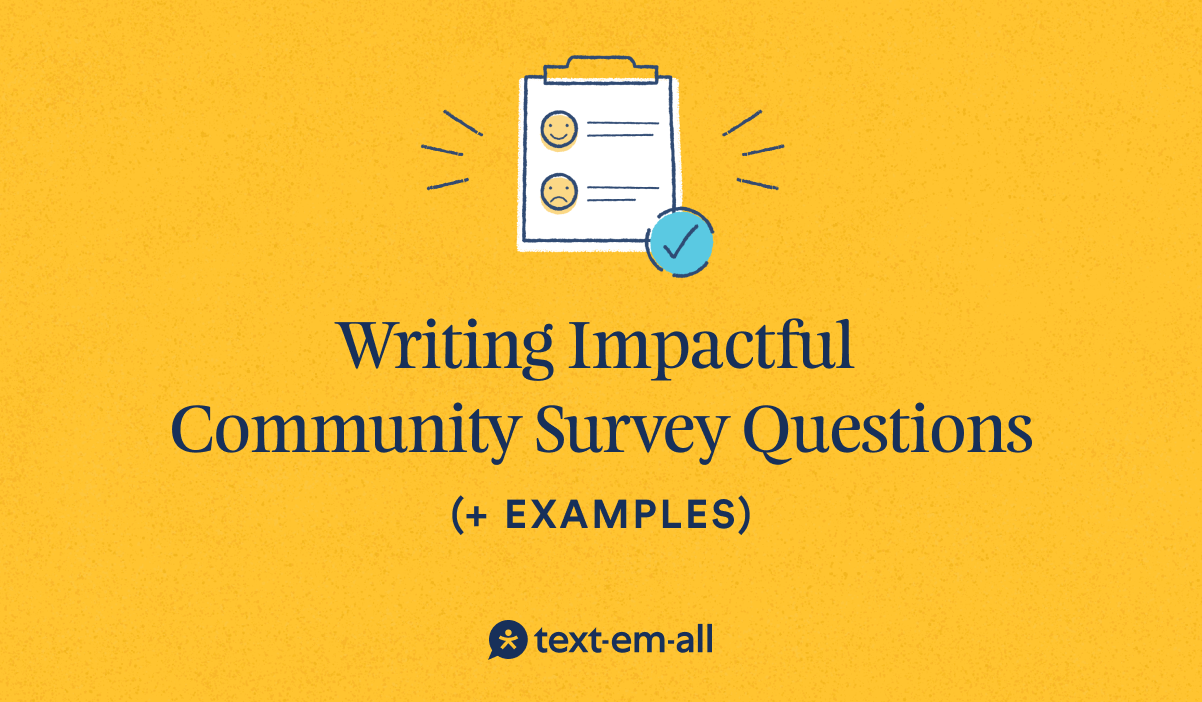
Collecting feedback is crucial for informed decisions, and community surveys are an easy yet effective way to hear from people who use your services.
But for survey research to be effective, you need to make sure you're asking the right questions. Gaining the right insights into your community's needs will help drive your work, and focusing on quality community survey questions can help you collect better-quality data.
In this blog post, we'll explore the power of community surveys and how they can help you make informed decisions and improve your services. Let’s dive in!
What is a Community Survey?
At its core, a community survey is a structured set of questions designed to gather feedback, opinions, and insights from a specific group of individuals within a community. This group could be defined by various factors such as location, demographics, or shared interests.
Community surveys can cover a wide range of topics, from satisfaction with current services to suggestions for improvement, from demographic information to opinions on proposed changes or initiatives. The key is to craft questions that are relevant, clear, and unbiased, ensuring that the data collected is accurate and actionable.
How to Create an Effective Community Survey
Follow these key steps to create a community survey that drives results.
1. Define Your Objectives
It’s easy to draft a community survey, but it’s essential to put thought behind your questions so the survey has meaning. One of the best ways to ensure your survey provides a meaningful outcome is to define the objectives—what do you want to know?
Ask yourself questions such as:
- What do you want to get from the survey?
- What will you do with the data and insights collected?
- What sort of questions will help you get the information you need?
- Will this be an ongoing survey, or will it have a defined period?
Answering these questions can help you nail down your survey's purpose and make sure that what you do is worthwhile.
Setting SMART objectives is another way to ensure that your work answers your main question. SMART objectives are:
- Specific: Be clear about what you want to do.
- Measurable: How will you measure success?
- Achievable: Is your goal attainable?
- Realistic: Do you have what you need to achieve your goals, including the time and resources?
- Time-constrained: What is your deadline? When do you need your answers?
Once you've set objectives you're happy with, you can use them to inform your community survey form.
2. Think About Your Audience
In addition to defining your objectives, you must also think about your audience.
Ask yourself these questions:
- Do you want to survey everyone in your community, or are there specific demographics you want to reach?
- What age groups do you want to target with your survey?
- Do you want to focus on any geographic locations or regions within your community?
- When designing your survey, do you need to consider language preferences or cultural backgrounds?
Carefully thinking about your audience will help you decide on the questions you need to ask them.
3. Draft Your Community Survey Questions
Drafting your community survey questions can be one of the trickiest parts of survey creation. We’ll guide you through some best practices for creating your community survey questions below in the section: Community Survey Question Examples: Dos and Don’ts
Designing Your Survey for Engagement
Designing an engaging survey is key to gathering valuable insights from your community. Let's explore some common questions and best practices for designing survey questions that yield meaningful responses.
Include Common Survey Questions
A useful way to start your community survey is by asking some common community survey questions.
These include:
- What is your age?
- Where do you live?
- What is your gender?
These questions can help you understand your audience better by gathering insights about their age or location.
Other questions that can help you gain useful insights from your community include:
- How often do you use our product or service?
- What features or aspects of our product or service do you find most valuable?
- How satisfied are you with the customer support you received?
- Have you encountered any challenges or difficulties while using our product or service?
- What improvements would you like to see in our product or service?
- Is there anything else you would like to share or any additional feedback you have for us?
Consider Question Formats Carefully
When designing your survey questions, consider the question formats carefully. Because of gaps and grey areas, participants may not provide their preferred answer, so ask questions with appropriate answer options.
Surveys often provide a lot of flexibility, allowing you to create questions with single- or multiple-choice answers, open-ended questions, rating questions, and more.
Some common question formats include:
- Multiple-choice questions
- Rating scales
- Likert scales
- Matrix questions
- Dropdown questions
- Open-ended questions
Community Survey Question Examples: Dos and Don’ts
When writing your questions, there are a few rules of thumb that you should follow. Here are some examples of what to look for.
Ensure Clarity
Ensuring that your survey questions are clear and easy to understand for participants is crucial. Ambiguous or confusing questions can lead to inaccurate responses and undermine the validity of your survey data. To ensure clarity:
- Use simple and straightforward language that is accessible to all participants.
- Avoid jargon or technical terms that may be unfamiliar to some respondents.
- Break down complex questions into smaller, more digestible parts if necessary.
- Give clear instructions or examples to help participants understand how to answer.
- Test your survey with a small group before sharing it widely to identify any confusion or misunderstandings.
By prioritizing clarity in your survey questions, you can maximize response rates and obtain more accurate data from your community.
Avoid Open-Ended Questions
Open-ended questions can be a good way to gain deeper insights into the subjects you're asking about. However, when data becomes qualitative (based on concepts instead of numbers), it can be more difficult and time-consuming to measure and analyze.
If you can get a more defined response to your question, avoid asking open-ended questions. Save the open-ended question to gather further insights and feedback that hasn't been captured elsewhere.
Be Smart With The Survey Journey
Surveys should be short, easy to read, and easy to navigate. If a survey takes too long, people may lose interest and either abandon the survey or select random answers to get it finished. Short surveys are preferable, but if you need a longer one, offer a reward to motivate people to finish the whole survey.
Another thing to consider is whether you can save your participants time. If there are follow-up questions to an opening question, such as 'Do you have a pet?', allow people to be able to skip ahead further in the survey. This is called 'skip logic' and helps you provide a good user experience for your participants. It's also helpful to show a completion percentage in surveys so people know how much they've done and feel encouraged to finish.
Read The Complete Guide to Business Text Messaging
Preparing for Survey Deployment
After completing your community survey questions, it's understandable that you'll want to release them as soon as possible. However, before sending out the survey, you should check to ensure it is clear, estimate how long it will take participants to complete, and identify any mistakes.
Firstly, consider testing the survey internally among colleagues to ensure clarity, functionality, and user-friendliness. Their feedback can help you uncover potential issues and refine the survey before wider distribution.
Once internal testing is complete, try a small study with some people from your target audience to see how it goes. This allows you to gather feedback on survey length, question clarity, and overall user experience from real respondents.
Lastly, identify any survey errors, such as typos, formatting issues, or technical glitches, and make necessary adjustments before deployment. This meticulous preparation ensures a smooth survey deployment process and enhances the quality of data collected.
Deploying Your Community Survey
Now, it's time to send your survey to your community. You can do this through various methods, including phone, mail, and email. Targeting members directly can be an effective way to make sure you're sending it to the right people. However, if you want more people to take your survey, share it on different platforms. This approach will help you reach a larger audience and collect more responses.
Remember to Send Reminders
Once you send your survey, it's a good idea to monitor the incoming responses. You can keep an eye on the completion rates to help you make decisions about further targeting and promotion.
Sending polite text reminders near your survey's closing date can prompt people to take action if they know there's limited time left.
Analyzing Your Responses
Once your responses are in, you can get to work analyzing them. This is where your hard work will pay off. You'll need to clear any incomplete or duplicate surveys and organize your data to make it easy to analyze. Some survey builders will convert responses into analytics for you, or you can transfer your data to a spreadsheet ready for you to evaluate.
When creating a data report for others to read, use tables and graphs to make the information easier to understand. If you have open-ended questions, analyze responses carefully. Highlight selected responses in your report for emphasis.
Elevate Community Engagement with Text-Em-All
The best way to reach a large audience is by using an automated calling and mass text messaging system, such as Text-Em-All. We deliver personalized, informational, mass text messages and phone calls fast—whether they’re going to five people or 50,000.
A few ways you can use our platform to send a survey include:
- Using our surveys feature for short “Yes/No” questions
- Using our Keywords feature
- Sending a link to your survey
To give us a try, create your free account today! Send your first community survey with us and see the power of mass messaging at work.












